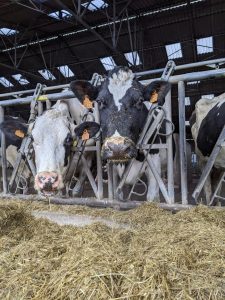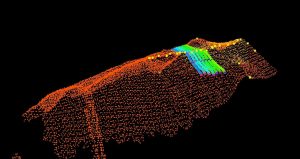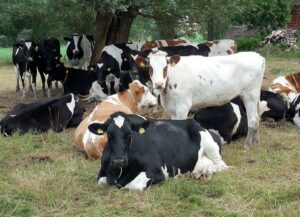Álvaro García
Not so long ago, I participated of a debate on LinkedIn that cut to the heart of an important controversy in the cattle industry. On the one side was a seasoned hoof trimmer; on the other, a fellow professional questioning whether his craft might be doing more harm than good eventually. And both made good points. The criticism was sharp: by expertly correcting hoof problems, trimmers may be concealing underlying genetic flaws in otherwise high-producing cows. Those animals, spared from early culling, can pass their conformation weaknesses to the descendants, ensuring the problem persists rather than disappears.
There is no denying the value of hoof trimming for animal well-being. In barns with abrasive flooring, poor drainage, or unhygienic conditions, trimming can be the difference between chronic pain and productive life. But when lameness is not caused by management or housing, the conversation shifts from treatment to prevention, and prevention starts long before a heifer takes her first step. Genetic selection for proper foot angle, claw shape, and limb conformation is one of the most powerful tools for building herds with lifelong hoof soundness. Without it, trimming becomes a recurring patch job, and poor management only accelerates the decline.
Hoof trimming is indispensable. It corrects imbalances, prevents lesions, and treats painful conditions such as sole ulcers, white line disease, and overgrowth. Regular trimming supports cow comfort, feed intake, fertility, and milk yield. For many high-output herds, especially in confined systems, trimming is the base of preventive care. Yet, this success can create a genetic blind spot.
When management masks genetics
Some cows remain mobile and productive thanks to consistent trimming, despite having genetically weak hoof or leg structure. Without intervention, these cows might develop chronic lameness, leave the herd early, and be naturally excluded from breeding. But when management keeps them going, they continue to breed — quietly passing structural flaws to the next generation.
In these cases, trimming becomes more than a welfare tool; it becomes a shield that hides heritable weaknesses from selection pressure. Over time, the proportion of animals requiring ongoing intervention can grow, increasing both labor demands and long-term costs.
By keeping structurally unsound animals in production, we risk breeding the very problems we work so hard to trim away.
The genetics behind hoof traits
Research shows that hoof-related traits are moderately heritable, meaning improvement is possible within a few generations of targeted selection. Key traits include hoof angle, heel depth, claw set, rear leg structure, and digital cushion thickness.
Van der Waaij et al. (2005) reported heritability ranging from 0.02 to 0.13 for common hoof disorders in Finnish Holsteins, and 0.10 to 0.19 for feet and leg conformation traits. Toussaint Raven (1985) found even higher heritability (above 0.30) for hoof angle and heel depth, indicating strong potential for genetic improvement.
Recent genomic research has identified specific markers linked to hoof health, including copy number variants (CNVs), sections of DNA duplicated or deleted, altering gene copy numbers and protein production. When CNVs involve genes for hoof structure, skin integrity, or immune function, they can influence susceptibility to conditions such as digital dermatitis or sole ulcers. Similarly, Gruber et al. (2020) found that breeds like Austrian Fleckvieh and Braunvieh carry unique single nucleotide polymorphisms (SNPs), single-letter DNA changes, associated with hoof disorders. These breed-specific markers underscore the importance of designing selection strategies that fit each breed’s genetic profile rather than applying a one-size-fits-all approach.
Striking the balance: management and genetics
The solution is not to abandon hoof trimming, but to integrate it with informed breeding decisions. Recording hoof health for individual animals, linking recurring problems to bloodlines, and incorporating hoof traits into sire and dam selection. Breeding programs should give weight to conformation and mobility alongside production traits, ensuring chronic problem cows are not kept in the gene pool simply because they perform well in the parlor.
Selecting for longevity and structural soundness benefits both cow well-being and economics. Cows that walk well, breed back efficiently, and last multiple lactations tend to have lower veterinary costs and higher lifetime productivity.
Poor hoof genetics do not just compromise well-being, they erode profitability. Lameness is among the top three most costly health problems in dairy herds, with costs per-case estimated at $185 to $550 depending on severity and production stage.
When structural weakness is inherited, these losses recur year after year. Lame cows can lose 200–500 kg of milk per lactation, take 20–40 extra days to conceive, and are often culled early, incurring replacement costs of $1,500–$2,300 per head. Ongoing trimming, medication, and handling consume labor that could be used elsewhere.
3D locomotion cameras should detect trends, not just lame cows
In dairy production, lameness often develops weeks before obvious signs appear. 3D camera-based locomotion systems can now monitor gait in real time, but most are tuned to flag cows only once they reach a Sprecher score of 3 or higher, “lame or no lame” cows. At this point the lesion is established, pain is significant, the hoof trimmer is warranted, and the recovery is more costly.
The real value lies in detecting subtle, progressive changes before they become scorable problems. Combined with AI interpretation of spine curvature, systems (such as with the Dellait Livestock 3D System), the 3D camera can provide early risk assessments by spotting minor asymmetries, reduced stride length, altered step arc, or subtle back posture changes, often weeks before lameness is visible. Tracking each cow’s baseline gait and alerting managers to gradual deviations allows for timely, low-cost interventions.
Intervening at the subclinical stage can be as simple as adjusting flooring, grooming bedding, adding rubber matting, fine-tuning nutrition to prevent hoof lesions, altering cow traffic to reduce slips, or reducing standing times for vulnerable cows.
The road ahead
To fulfill their preventive role, 3D camera systems must record individual gait baselines early in a cow’s life, monitor passively in high-traffic areas, and flag gradual deviations rather than waiting for severe lameness. Linking these data to health and production records enables targeted interventions. Crucially, technology should guide, not replace, skilled human evaluation.
Relying on trimming or technology alone risks treating symptoms instead of causes. Used together, trimming for comfort, genetics for structural resilience, and 3D cameras for early warnings, these tools can align short-term cow well-being needs with long-term herd improvement.
By combining management, breeding, and technology, producers can create herds that are not only productive but built to stay sound for years to come.
© 2025 Dellait Knowledge Center. All Rights Reserved.









